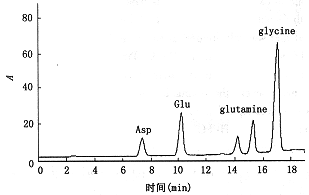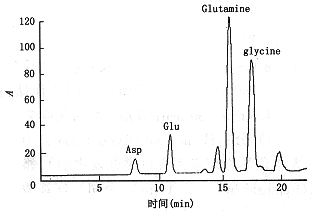关键词:脑外伤 脑脊液 兴奋性氨基酸 高效液相色谱法
【摘要 】 目的 探讨脑外伤患者脑脊液中兴奋性氨基酸的变化。方法 用邻苯二甲醛柱前衍生后,采用梯度高效液相色谱荧光检测法测定42例脑外伤,9例对照者脑脊液中兴奋性氨基酸——天门冬氨酸(Asp)和谷氨酸(Glu)。结果 42例脑外伤患者脑脊液中Asp,Glu测值(Asp:1.878±0.729 μmol/L, Glu:7.985±6.325 μmol/L)明显高于正常对照组(Asp:1.362±0.220,P<0.05),Glu:1.914±1.507,P<0.001)。26例重伤组脑脊液中Asp,Glu测值(2.402±1.157 μmol/L,10.252±6.570 μmol/L)明显高于轻伤组(1.732±0.595 μmol/L,P<0.001,4.301±3.741 μmol/L,P<0.05)。脑外伤预后良好(良好;中残)组(Asp:1.835±0.705 μmol/L,Glu:6.307±4.171 μmol/L,n=24)与预后不良(重残;植物生存;死亡)组(Asp:2.588±1.089 μmol/L,Glu:12.530±7.269 μmol/L,n=18)相比较,二组差异有非常显著意义(Asp:P<0.01,Glu:P<0.001)。结论 脑外伤患者伤情愈重,脑脊液中兴奋性氨基酸浓度愈高;浓度愈高,脑外伤预后愈差。
Determination of excitatory amino acids in cerebrospinal fluid after cerebral injury and clinical significance Zhang Hong, Zhai Suodi, Li Jiaren, et al. Department of Pharmacy, First Affiliated Hospital, Lanzhou Medical College, Lanzhou 730000
【Abstract 】 Objective To study the change of excitatory amino——acids in cerebrospinal fluid after cerebral injury.Methods The concentration of exitatory amino aspartate and glutamate in cerebrospinal fluid was measured in 42 brain injured adults and 9 controls by precolumn derivatization with O-phthaldehyde.Results The concentrations of excitatory amino acids in the cerebrospinal fluid of brain injured and severely injured group were higher than those of the controls (asp, P<0.05; Glu, P<0.001) and mild injured group (Asp, P<0.05; Glu, P<0.001). The excitatory amino acids values of poor-outcome cases were conspicuously higher than those of good-outcome cases (Asp, P<0.05; Glu,P<0.001).Conclusions The more severe the traumatic degree and the more poorer outcome, the higher concentration of exitatory amino acids in cerebrospinal fluid.
【Key words 】 Cerebral injury Cerebrospinal fluid Excitatory amino acids HPLC
自70年代末发现谷氨酸(Glutamate, Glu)对哺乳类动物神经元有毒性作用以来,近10余年兴奋性毒性理论日益发展并受到重视[1~3] ,已成为解释脑外伤、癫痫发作及低血糖等情况下,继发性脑损伤、脑水肿的重要理论之一。动物实验应用微透析法测定脑细胞外液兴奋性氨基酸,此法难以用于临床研究,因而人类脑外伤后兴奋性氨基酸变化论据很少。据文献[4] 脑细胞外液和脑脊液之间,一些亲水性小分子物质如天门冬氨酸(Aspartate, Asp)和Glu可以自由双向扩散,脑脊液中含量能相对体现细胞外液中的含量。故检测脑脊液中兴奋性氨基酸(Glu, Asp)有重要临床意义。高效液相色谱法测定脑脊液中氨基酸已有报道[5~7] ,但国内较为少见[8] ,作者用高效液相色谱法测定42例脑外伤及9例对照者脑脊液中兴奋性氨基酸,报告如下。
材料与方法
一、仪器与试剂
Pekin Elmer高效液相色谱仪:包括200型二元梯度泵、LC240荧光检测器、1022小型工作站,保护柱:ODS 4.6 mm×50 mm,10 μm(兰州化学物理研究所色谱组),分析柱:ucleosil ODS 6.0 mm×200 mm,7 μm(大连化学物理研究所色谱开发中心),邻苯二甲醛(O-phthaldehyde, OPA, fluka公司),氨基酸标准品(Singma公司),甲醇为分析纯经重蒸纯化,其余试剂均为分析纯,所有溶液用去离子水配制。
二、实验方法
1.衍生化试剂配制及衍生化过程:100 mg OPA以5 ml甲醇溶解,加50 μl巯基乙醇,4℃避光保存,1周内使用。50 μl脑脊液中加入50 μl衍生化试剂和500 μl硼酸缓冲液(0.4 mol/L,pH=9.25),在室温下反应2分钟进样15 μl。
2.色谱条件:二元梯度洗脱,流动相A:四氢呋喃∶甲醇∶0.1 mol/L乙酸钠(5∶95∶900,pH=7)含0.04 mol/L叠氮钠;流动相B:甲醇,流速1 ml/min,梯度程序中流动相A的含量为:第0~5分钟为100%~75%、5~10分钟为75%~65%、10~15分钟为65%~45%、15~17分钟为45%~20%、17~19分钟为20%~5%、19分钟后维持5%。激发波长330 nm,发射波长445 nm,外标法定量。
3.脑脊液采集与提取:急性脑外伤、脑水肿颅内压(ICP)监护病人均于侧脑室穿刺时采集一次,监护期内每隔24小时采样一次,非ICP监护者腰穿采样,对照组于腰麻时采样,采集脑脊液2 ml于-35℃贮存待测。测定时取100 μl脑脊液与100 μl甲醇震荡混合,15 000 r/min离心5分钟,上清液进行衍生化,色谱图见图1、2。
图1 氨基酸标准品色谱图
图2 正常脑脊液色谱图
4.统计学分析:检测结果用
结果
1.标准曲线:天门冬氨酸溶液浓度在0.385~6.161 μmol/L范围内以浓度(C)对其相应的峰面积(A)做回归方程,A=601 448+342 389C r=0.997 1 (n=5)。谷氨酸标准溶液浓度在0.650~10.400 μmol/L范围内以浓度(C)对其相应的峰面积(A)做回归方程,A=742 829+1 262 050C r=0.998 6(n=5)。
2.精密度与回收率:配制已知Asp,Glu浓度的脑脊液若干份,测得批内CV(Asp)=5.77%(0.921 μmol/L),CV(Glu)=5.46%(6.946 μmol/L);批间CV(Asp)=7.34%(0.921 μmol/l),CV(Glu)=5.31%(6.946 μmol/L)。向已知浓度的脑脊液中加入一定量的标准液,测得Asp,Glu的加样回收率分别为97.9%(Asp加入量0.385 μmol/L)、98.5%(Asp加入量3.080 μmol/L),98.1%(Glu加入量0.650 μmol/L)、98.8%(Glu加入量5.200 μmol/L)。
3.样品测定结果:42例脑外伤患者脑脊液中Asp,Glu测值(Asp:1.878±0.729 μmol/L,Glu:7.985±6.325 μmol/L)明显高于正常对照组(Asp:1.362±0.220,P<0.05,Glu:1.914±1.507,P<0.001)。26例重伤组脑脊液中Asp,Glu测值(2.402±1.157 μmol/l,10.252±6.570 μmol/L)明显高于轻伤组(1.732±0.595 μmol/L,P<0.001),4.301±3.741 μmol/L,P<0.05)。脑外伤预后良好(良好;中残)组(Asp:1.835±0.705 μmol/L, Glu:6.307±4.171 μmol/L, n=24)与预后不良(重残;植物生存;死亡)组(Asp: 2.588±1.089 μmol/L,Glu:12.530±7.269 μmol/L,n=18)相比较,二组差异有非常显著意义(Asp:P<0.01,Glu:P<0.001)。
讨论
实验中发现,贮存于0.5 mol/L HCl中的谷氨酰胺标准溶液,新配制时,色谱图为单一谷氨酰胺峰,4℃放置6天后,再次进样,除谷氨酰胺峰外又出现一个与谷氨酸峰保留时间及紫外光谱完全一致的色谱峰,这说明酸性条件下部分谷氨酰胺水解为谷氨酸,因此,测定生物样品中氨基酸时不宜选用酸性蛋白沉淀剂。
实验结果脑外伤及重伤组脑脊液中兴奋性氨基酸明显高于对照组及轻伤组,与文献[4] 一致。结果还显示脑外伤者脑脊液中兴奋性氨基酸浓度与预后显著相关,表明脑外伤后脑细胞外液积聚了超生理浓度的兴奋性氨基酸,且伤情愈重浓度愈高。过量的兴奋性氨基酸可导致兴奋性毒性作用,引起继发性脑损害、脑水肿[1~3] 。因此,抗兴奋性毒性治疗可能成为防止创伤后脑损害、脑水肿的新途径。
参考文献
1 Meldrum B. Amino acids as dietory excitotoxins: a contribution to understanding neurodegenerative disorders. Brain Res Brain Res Rev, 1993,18:293-314.
2 Amara SG. Neurotransmitter transporters. A tale of two families. Nature, 1992,360:420-421.
3 Albin RL, Greenamyre JT. Alternative excitotoxic hypotheses. Neurology, 1992,42:733-738.
4 Baker AJ, Moulton RJ, Macmillan VH, et al. Excitatory amino acids in cerebrospinal fluid following traumatic brain injury in humans. J Neurosurg, 1993,79:369-372.
5 Goldsmith RF. Earl JW, Cunnigham AM. Determination of delta-aminobutyric acid and other amino acids in cerebrospinal fluid of pediatric patients by reversed-phase liquid chromatography. Clin Chim, 1987,33:1736-1740.
6 Begley DJ, Reichel A, Ermisch A. Simple high-performance liquid chromatographic analysis of free primary amino acid concentrations in rat plasma and cisternal cerebrospinal fluid. J Chromatogr B Biomed Appl, 1994,657:185-191.
7 Alfredsson G, Wiesel FA, Lindberg M. Glutamate and glutamine in cerebrospinal fluid and serum from healthy volunteers analytical aspects. J Chromatogr, 1988,424:378-384.
8 丁敏,曾成鸣.柱前衍生高效液相色谱法分析脑脊液氨基酸.上海医学检验杂志,1995,20:24-25.
(收稿:1998-01-04 修回:1998-08-20)
, http://www.100md.com
